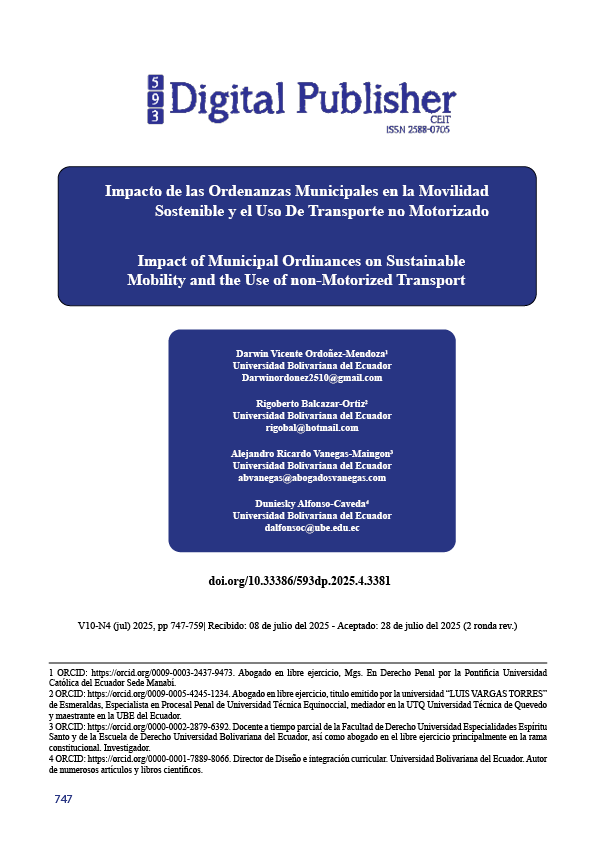Impact of Municipal Ordinances on Sustainable Mobility and the Use of non-Motorized Transport
Main Article Content
Abstract
Municipal ordinances are key instruments for promoting sustainable mobility and the use of non-motorized transportation, such as cycling and walking. Their impact is evident when they promote adequate infrastructure, restrict car use in certain areas, and offer incentives for active mobility. However, the lack of coordination between local authorities and weak oversight limit their reach. Therefore, it is essential that ordinances be well-structured, aligned with sustainability policies, and focused on ensuring road safety and accessibility.
This research is aimed at the Decentralized Autonomous Government of the City of Santo Domingo to strengthen the regulatory and operational framework of municipal ordinances governing non-motorized transportation. For this purpose, empirical and statistical methods were used to conduct a comprehensive evolutionary analysis of the object of study and its current phenomenological trends. This justifies the need for proper implementation of municipal ordinances that benefit citizens by encouraging the use of non-motorized transportation.
Downloads
Article Details

This work is licensed under a Creative Commons Attribution-NonCommercial-ShareAlike 4.0 International License.
1. Derechos de autor
Las obras que se publican en 593 Digital Publisher CEIT están sujetas a los siguientes términos:
1.1. 593 Digital Publisher CEIT, conserva los derechos patrimoniales (copyright) de las obras publicadas, favorece y permite la reutilización de las mismas bajo la licencia Licencia Creative Commons 4.0 de Reconocimiento-NoComercial-CompartirIgual 4.0, por lo cual se pueden copiar, usar, difundir, transmitir y exponer públicamente, siempre que:
1.1.a. Se cite la autoría y fuente original de su publicación (revista, editorial, URL).
1.1.b. No se usen para fines comerciales u onerosos.
1.1.c. Se mencione la existencia y especificaciones de esta licencia de uso.
References
Abarca, J. P. M., & Arroyo, R. G. (2024). Metodologías de investigación y usos de la inteligencia artificial aplicada al periodismo. Comunicación & Métodos, 6(1), 90-107.
Bambarén, C., & Chú, M. (2013). Regulación del transporte y accidentes de tránsito por vehículos motorizados en el Perú. Revista Médica Herediana, 24(4), 305-310.
Daniels Rodríguez, M. C., & Castro Paredes, M. I. (2011). Metodología de la investigación jurídica. https://cdigital.uv.mx/bitstream/handle/123456789/36358/danielsrodriguezmartha.pdf
de Cuenca, C. C. (2012). ORDENANZA QUE REGULA Y CONTROLA LA OCUPACIÓN DE LAS VÍAS PÚBLICAS POR LOS VEHÍCULOS MOTORIZADOS DENTRO DEL CANTÓN CUENCA Y EL FUNCIONAMIENTO DEL SISTEMA DE ESTACIONAMIENTO ROTATIVO TARIFADO Y PARQUEO INDEBIDO-SERT EN EL CANTÓN CUENCA. Registro Oficial,(765). https://www.emov.gob.ec/sites/default/files/transparencia/a2.23.pdf
Gómez, H. B. (2013). El actual modelo de descentralización en el Ecuador: Un desafío para los gobiernos autónomos descentralizados. FORO: Revista de derecho, 20, 5-22.
González, E. L. (2016). El método científico. Revista de la Universidad de Costa Rica, 1(1), 165-169.
MUÑOZ. (2017). DICCIONARIO PREHISPANICO JURIDICO.
Núñez Tene, J. E., & Veloz Camacho, J. A. (2022). Propuesta de estrategias de sostenibilidad para mejorar el transporte no motorizado del cantón Baños de Agua Santa, provincia de Tungurahua. http://dspace.espoch.edu.ec/handle/123456789/18671
SIERRA LOPEZ, E. (2017). El principio de eficacia administrativa como criterio complementario del principio de legalidad en el Derecho administrativo [Master’s Thesis, UAEM]. http://ri.uaemex.mx/handle/20.500.11799/66178
Wunder Hachem, D., & Gabardo, E. (2018). El principio constitucional de eficiencia administrativa: Contenido normativo y consecuencias jurídicas de su violación. Cuestiones constitucionales, 39, 131-167.





